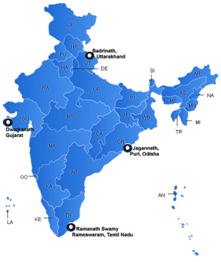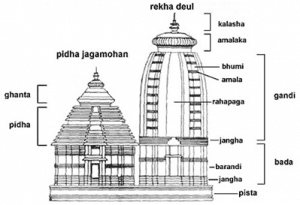Table of Contents
POLITY AND CONSTITUTION
1. PURI’S JAGANNATH TEMPLE: WHY NON-HINDUS AND FOREIGNERS CAN’T ENTER HERE
Tags: GS-II- Indian Polity- Prelims Perspective
THE CONTEXT: Odisha Governor Ganeshi Lal has backed the entry of foreign nationals inside the world-famous Jagannath Temple in Puri, wading into a debate that has lasted for decades and periodically triggered controversy.
THE EXPLANATION:
- According to Governor “If a foreigner can meet Gajapati, servitors, and Jagatguru Shankaracharya, he/ she should also be allowed to meet eyes with the Chakanayana (a name of Lord Jagannath). It is my personal opinion irrespective of whether people will appreciate it or not”.
- Servitors at the 12th-century shrine and researchers of Jagannath culture have expectedly opposed the suggestion, saying that the traditions and practices of the Temple should not be broken.
The Jagannath Temple
- The Temple is one of the four dhams (char dham) where Lord Jagannath, a form of Lord Vishnu, is worshipped along with his elder brother Lord Balabhadra and sister Devi Subhadra. Only Hindus are allowed inside the shrine to offer prayers to the sibling deities in the sanctum sanctorum. A sign at the Lion’s Gate (main entrance) of the Temple clearly states: “Only Hindus are allowed.”
Why no non-Hindus?
- It has been the practice for centuries — even though there is no clearly articulated reason for it. Some historians believe that multiple attacks on the Temple by Muslim rulers might have led the servitors to impose restrictions on the entry of non-Hindus. Others have said that this was the practice from the time the Temple was built.
Patitapaban darshan
- Lord Jagannath is also known as Patitabapan which literally means “saviour of the downtrodden”. So all those who are barred from entering the Temple because of religious reasons get the privilege of a darshan of the Lord in the form of Patitapaban at the Lion’s Gate.
When the Lord emerges
- Jagannath, Lord of the Universe, comes to Bada Danda (the Grand Road) along with his siblings during the nine-day Rath Yatra (car festival) in June-July every year — an occasion when non-Hindus can have His darshan. As the deities go on a sojourn to the Gundicha temple, their birthplace, devotees from around the world throng Puri for a glimpse of the Lord.

2. HALWA, BRIEFCASE, AND OTHER UNION BUDGET-RELATED FACTS
TAGS: PRELIMS PERSPECTIVE-
THE CONTEXT: The final stage of the Budget preparation process for 2023 kicked off with the traditional halwa ceremony on January 26 at the North Block, which houses the Finance ministry.
THE EXPLANATION:
Finance Minister will present the Budget on February 1. The halwa ceremony resumed this year after a Covid-induced break.
What is the Budget halwa ceremony?
- Held some days before the Budget is to be presented, the halwa ceremony involves the Finance Minister stirring a large pan of the halwa, and the sweet then being distributed to ministry officials and staff members.
- The ceremony marks the beginning of the budget ‘lock-in’ period. After the halwa is served, officials and support staff directly associated with the Budget process – its preparation and printing — stay in the North Block, cut off from everyone, including their families, till the Budget is presented. This is done to maintain the secrecy of the Union Budget.
- The lock-in period ends only after the Finance Minister has given the Budget speech in Lok Sabha. The halwa is a gesture of appreciation for all those who work to bring out the Budget.
Briefcase and bahikhata
- Till 2018, Finance Ministers carried the Budget papers to Parliament in a briefcase, a British-era tradition. However, in 2019, brought the documents in a red cloth tied with a string, with the national emblem emblazoned on it.
- Red clothes are usually used to cover religious texts. Then Chief Economic Advisor had called it a sign of “departure from slavery of Western slavery”. “It is in Indian tradition. It symbolises our departure from slavery of Western thought. It is not a budget but a ‘bahikhata’ (ledger)”.
PRELIMS PERSPECTIVE
- THE FIRST EVER BUDGET: India’s first Budget was announced in pre-independent India, on April 7, 1860, when Scottish economist and politician James Wilson – of the East India Company – presented it to the British Crown.
- Post Independence, India’s first budget was presented on November 26, 1947 by then Finance Minister R K Shanmukham Chetty.
Who has presented the most Budgets?
- Former Prime Minister Morarji Desai holds the record of presenting the most number of Budgets of all time. He presented 10 budgets during his stint as Finance Minister during 1962-69, followed by P Chidambaram (nine), Pranab Mukherjee (eight).
- The Black Budget: The 1973-74 Budget presented by Yashwantrao B Chavan in the Indira Gandhi government was called the Black Budget as the fiscal deficit during that year was Rs 550 crore. It was a time when India was going through acute financial distress.
- Carrot & Stick Budget: The Union budget presented by VP Singh for the Congress government on February 28, 1986, was the first step towards dismantling licence raj in India. It was called the ‘Carrot and Stick’ budget as it offered both rewards and punishment. It introduced MODVAT (Modified Value Added Tax) credit for lowering the cascading effect of tax that consumers had to pay while also launching an intense drive against smugglers, black marketers, and tax evaders.
- Epochal budget: Manmohan Singh’s landmark 1991 budget under the PV Narasimha Rao government that ended licence raj and began the era of economic liberalisation, is known as ‘Epochal Budget’. Presented at a time when India was on the brink of an economic collapse, it among other things slashed customs duty from 220 per cent to 150 per cent and took steps to promote exports.
- Dream Budget: P Chidambaram in the 1997-98 budget used the Laffer Curve principle to lower tax rates to increase collections. He slashed maximum marginal income tax rate for individuals from 40 per cent to 30 per cent and that for domestic companies to 35 per cent besides unleashing a number of major tax reforms including a voluntary disclosure of income scheme to recover black money. Referred to as the ‘Dream Budget’, it also slashed customs duty to 40 per cent and simplified excise duty structure.
- Millennium Budget: Yashwant Sinha’s Millennium Budget in 2000 laid the road map for the growth of India’s Information Technology (IT) industry as it phased out incentives on software exporters and lowered customs duty on 21 items such as the computer and computer accessories.
- Rollback Budget: Yashwant Sinha’s 2002-03 budget for the NDA government headed by Atal Bihari Vajpayee is popularly remembered as the Rollback Budget as several proposals in it were withdrawn or rolled back.
ENVIRONMENT, ECOLOGY & CLIMATE CHANGE
3. HOW DO COWS AND SHEEP CONTRIBUTE TO CLIMATE CHANGE?
Tags: GS-III- Environment & Climate change
THE CONTEXT: According to a report in the BBC, Microsoft co-founder Bill Gates has invested in an Australian climate technology start-up that aims to curtail the methane emissions of cow burps.
THE EXPLANATION:
- The start-up, Rumin8, has received funding worth $12 million from Breakthrough Energy Ventures, which Gates created in 2015. Amazon chief executive Jeff Bezos, and Chinese entrepreneur and Alibaba co-founder Jack Ma have also backed the Breakthrough fund.
- Rumin8 is developing a variety of dietary supplements to feed to cows in a bid to reduce the amount of methane they emit into the atmosphere. The supplement includes red seaweed, which is believed to drastically cut methane output in cows.
How do cows and other animals produce methane?
- Ruminant species are hooved grazing or browsing herbivores that chew cud. Ruminants such as cows, sheep, goats, and buffaloes have a special type of digestive system that allows them to break down and digest food that non-ruminant species would be unable to digest.
- Stomachs of ruminant animals have four compartments, one of which, the rumen, helps them to store partially digested food and let it ferment. This partially digested and fermented food is regurgitated by the animals who chew through it again and finish the digestive process.
- However, as grass and other vegetation ferments in the rumen, it generates methane, a potent greenhouse gas. Ruminant animals such as cows and sheep release this methane mainly through burping.
- Given the very large numbers of cattle and sheep on farms in dairy-producing countries, these emissions add up to a significant volume. It is estimated that the ruminant digestive system is responsible for 27 per cent of all methane emissions from human activity.
Why is methane such a big problem?
- Methane is one of the main drivers of climate change, responsible for 30 per cent of the warming since preindustrial times, second only to carbon dioxide. Over a 20-year period, methane is 80 times more potent at warming than carbon dioxide, according to a report by the United Nations Environment Programme.
- It’s also the primary contributor to the formation of ground-level ozone, a colourless and highly irritating gas that forms just above the Earth’s surface. According to a 2022 report, exposure to ground-level ozone could be contributing to 1 million premature deaths every year.
PRELIMS PERSPECTIVE
4. WHAT IS LIQUIFIED NATURAL GAS (LNG)?
Tags: Prelims perspective
THE CONTEXT: Recently, the EU is weaning itself off piped Russian gas by rapidly expanding imports of liquified natural gas, much of it fracked in the US.
THE EXPLANATION:
- LNG is to compensate for lost Russian gas supplies, with four new terminals set to come online in Germany alone. But though touted as a short-term fix, many fear the gas is here for the long haul as the EU becomes the biggest LNG importer in the world.
What is Liquified Natural Gas or LNG?
- LNG is natural gas reduced to a liquid state (liquefaction) through intense cooling to around -161 degrees Celsius (-259 Fahrenheit). This liquid gas is 600 times smaller than the original volume and is half the weight of water.
- The compressed fossil fuel, which is constituted almost wholly of methane — a potent greenhouse gas —, can be transported around the world by ship. After arriving at its destination, the cargo is re-gasified in a floating terminal and redistributed through pipelines.
- But despite LNG’s export potential, the high cost of liquefaction and producing LNG has limited its market. In Germany, the estimated cost of building floating LNG terminals for imports to substitute Russian gas has doubled, due in part to higher operating and infrastructure costs.
- The cooling, liquefying and transport processes, as well as the post-transport regasification procedures, also require a lot of energy. “Between 10-25% of the energy of the gas is being lost during the liquefaction process”.
5. CHARAIDEO MAIDAMS
Tags: Prelims Perspective
THE CONTEXT: Recently, Assam Chief Minister announced that the central government has decided to put forth the name of Assam’s Charaideomoidams burial sites for addition to United Nations Educational, Scientific and Cultural Organization’s (UNESCO) World Heritage Sites list.
THE EXPLANATION:
The Charaideomoidams are royal burial sites of the Ahom dynasty, which ruled over much of Assam and the North East from 1228 to 1826 AD. Located around 30 km from Sivasagar town in eastern Assam, even today, the tumuli in Charaideo are considered sacrosanct by many locals.
What are maidams?
- A maidam is a tumulus – a mound of earth raised over a grave – of Ahom royalty and aristocracy. While Charaideo exclusively contains maidams of Ahom royals, other moidams of aristocrats and chiefs can be found scattered across Eastern Assam, in the region between the towns of Jorhat and Dibrugarh.
- A typical maidam at Charaideo contains one or more chambers in a vault. On top of these is a hemispherical
 earthen mound, rising high above the ground, covered in grass. On top of this mound, there is a pavilion, known as the chow chali. A low octagonal wall surrounds the mound with one entrance.
earthen mound, rising high above the ground, covered in grass. On top of this mound, there is a pavilion, known as the chow chali. A low octagonal wall surrounds the mound with one entrance. - Ahom kings and queens were buried inside these maidams. Unlike Hindus who cremate their dead, the predominant funerary method of the Ahoms, originating from the Tai people, was the burial. The height of a maidam is typically indicative of the power and stature of the person buried inside. However, except for those of Gadadhar Singha and Rudra Singha, most moidams remain unidentified.
- Inside the chambers of the moidam, the dead king would be buried along with items he needed for the “afterlife”, as well as servants, horses, livestock and even their wives. It is the similarity of the Ahom burial rites with that of the ancient Egyptians that give Charaideo maidams the moniker of “Pyramids of Assam.”
Why was Charaideo important?
- The word Charaideo has been derived from three Tai Ahom words, Che-Rai-Doi. “Che” means city or town, “Rai” means “to shine” and “Doi” means hill. In short, Charaideo means, “a shining town situated on a hilltop.”
Spread the Word


 earthen mound, rising high above the ground, covered in grass. On top of this mound, there is a pavilion, known as the chow chali. A low octagonal wall surrounds the mound with one entrance.
earthen mound, rising high above the ground, covered in grass. On top of this mound, there is a pavilion, known as the chow chali. A low octagonal wall surrounds the mound with one entrance.